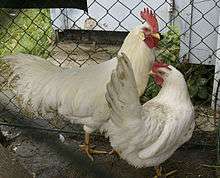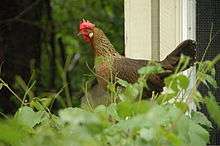Leghorn chicken
 Cock and hen | |
| Conservation status | FAO 2007: not at risk[1]:151 |
|---|---|
| Other names |
Livorno Livornese |
| Use | eggs |
| Traits | |
| Weight |
|
| Skin colour | yellow[2]:114 |
| Egg colour | white |
| Comb type | single or rose |
| Classification | |
| APA | Mediterranean[3] |
| EE | yes[4] |
| PCGB | soft feather: light[5] |
| |
The Leghorn (US: /ˈlɛɡhɔːrn/, UK: /lɛˈɡɔːrn/; Italian: Livorno or Livornese) is a breed of chicken originating in Tuscany, in central Italy. Birds were first exported to North America in 1828 from the port city of Livorno,[6] on the western coast of Tuscany. They were initially called "Italians", but by 1865 the breed was known as "Leghorn", the traditional anglicisation of "Livorno". The breed was introduced to Britain from the United States in 1870.[7] White Leghorns are commonly used as layer chickens in many countries of the world. Other Leghorn varieties are less common.
History
The origins of the Leghorn are not clear; it appears to derive from light breeds originating in rural Tuscany. The name comes from Leghorn, the traditional anglicisation of Livorno, the Tuscan port from which the first birds were exported to North America. The date of the first exports is variously reported as 1828,[6] "about 1830"[8] and 1852.[9] They were initially known as "Italians"; they were first referred to as "Leghorns" in 1865, in Worcester, Massachusetts.[10]
The Leghorn was included in the American Standard of Perfection in 1874, with three colours: black, white and brown (light and dark). Rose comb light and dark brown were added in 1883, and rose comb white in 1886. Single comb buff and silver followed in 1894, and red, black-tailed red, and Columbian in 1929. In 1981 rose comb black, buff, silver, and golden duckwing were added.[9]
The breed was first introduced to Britain from the United States in 1870, and from there re-exported to Italy.[6] White Leghorns that had won first prize at the 1868 New York Show were imported to Britain in 1870, and brown Leghorns from 1872.[11]:161 These birds were small, not exceeding 1.6 kg in weight; weight was increased by cross-breeding with Minorca and Malay stock.[11]:161 Pyle Leghorns were first bred in Britain in the 1880s; gold and silver duckwings originated there a few years later, from crosses with Phoenix or Japanese Yokohama birds. Buff Leghorns were first seen in Denmark in 1885, and in England in 1888.[12]
Characteristics

In Italy, where the Livorno breed standard is recent, ten colour varieties are recognised.[6] There is a separate Italian standard for the German Leghorn variety, the Italiana (German: Italiener).[6] The Fédération française des volailles (the French poultry federation) divides the breed into four types: the American white, the English white, the old type (golden-salmon) and the modern type, for which seventeen colour variants are listed for full-size birds, and fourteen for bantams; it also recognises an autosexing variety, the Cream Legbar.[13] Both the American Poultry Association and the American Bantam Association recognize a number of Leghorn varieties including white, red, black-tailed red, light brown, dark brown, black, buff, Columbian, buff Columbian, barred, and silver. In Britain, the Leghorn Club recognises eighteen colours: golden duckwing, silver duckwing, partridge, brown, buff, exchequer, Columbian, pyle, white, black, blue, mottled, cuckoo, blue-red, lavender, red, crele and buff Columbian.[7] Most Leghorns have single combs; a rose comb is permitted in some countries, but not in Italy. The legs are bright yellow, and the ear-lobes white.[6]
The Italian standard gives a weight range of 2.4–2.7 kg (5.3–6.0 lb) for cocks, 2.0–2.3 kg (4.4–5.1 lb) for hens.[6] According to the British standard, fully grown Leghorn cocks weigh 3.4 kg (7.5 lb), hens 2.5 kg; cockerels weigh 2.7–2.95 kg and pullets 2–2.25 kg; for bantams the maximum weight is 1020 g for cocks and 910 g for hens.[7] Ring size is 18 mm for cocks, 16 mm for hens.[13]
Use
Leghorns are good layers of white eggs, laying an average of 280 per year and sometimes reaching 300–320, with a weight of at least 55 g.[6] White Leghorns have been much used to create highly productive egg-laying hybrids for commercial and industrial operations.[11]:161
References
- ↑ Barbara Rischkowsky, D. Pilling (eds.) (2007). List of breeds documented in the Global Databank for Animal Genetic Resources, annex to The State of the World's Animal Genetic Resources for Food and Agriculture. Rome: Food and Agriculture Organization of the United Nations. ISBN 9789251057629. Accessed June 2017.
- ↑ [s.n.] (1998). The American Standard of Perfection. Mendon, Massachusetts: American Poultry Association.
- ↑ APA Recognized Breeds and Varieties: As of January 1, 2012. American Poultry Association. Archived 4 November 2017.
- ↑ Liste des races et variétés homologuée dans les pays EE (28.04.2013). Entente Européenne d’Aviculture et de Cuniculture. Archived 16 June 2013.
- ↑ Breed Classification. Poultry Club of Great Britain. Accessed August 2014.
- 1 2 3 4 5 6 7 8 Atlante delle razze di Polli - Razze italiane: Livorno Accessed December 2011. (in Italian) "Atlas of chicken breeds - Italian breeds: Livorno".
- 1 2 3 Standards The Leghorn Club. Accessed December 2011.
- ↑ Crawford, RD (1990) Poultry breeding and genetics Amsterdam; New York: Elsevier. ISBN 978-0-444-88557-9 p.46
- 1 2 Leghorn Chicken American Livestock Breeds Conservancy, 1993–2009. Accessed December 2011.
- ↑ Background On The Brown Leghorn Chicken American Brown Leghorn Club, 1998-2004. Accessed December 2011.
- 1 2 3 Victoria Roberts (2008). British poultry standards: complete specifications and judging points of all standardized breeds and varieties of poultry as compiled by the specialist breed clubs and recognised by the Poultry Club of Great Britain. Oxford: Blackwell. ISBN 9781405156424.
- ↑ Wright, Lewis; Sidney Herbert Lewer [1911?] Wright's book of poultry, revised and edited in accordance with the latest poultry club standards London; New York; Toronto; Melbourne: Cassell. pp.411–422
- 1 2 Liste des races et variétés de Gallinacés et Palmipèdes domestiques et diamètres des bagues en mm Fédération française des volailles. Accessed December 2011. (in French) "List of races and varieties of gallinaceous and web-footed poultry with ring diameters in mm"
External links
| Wikimedia Commons has media related to Leghorn. |